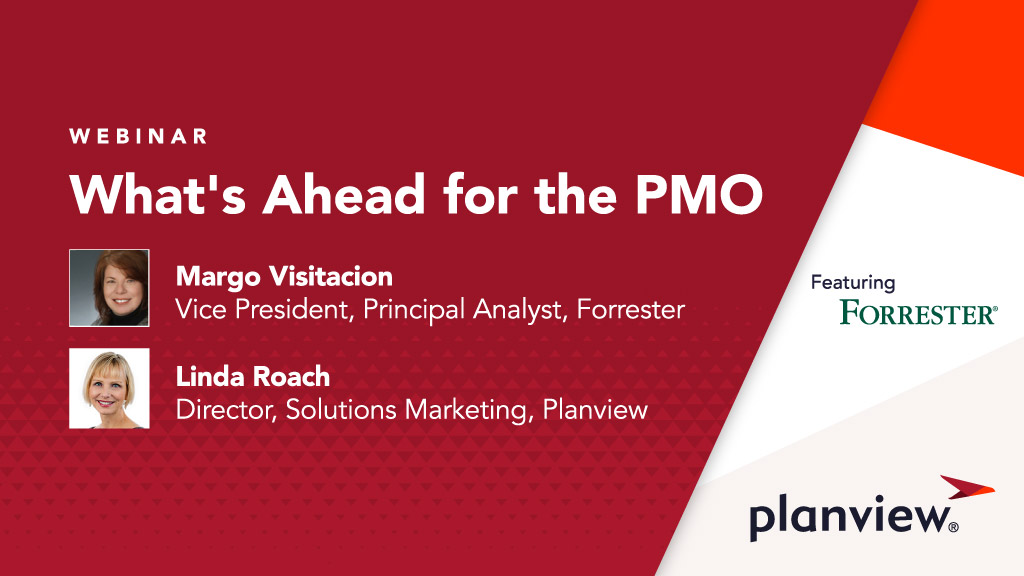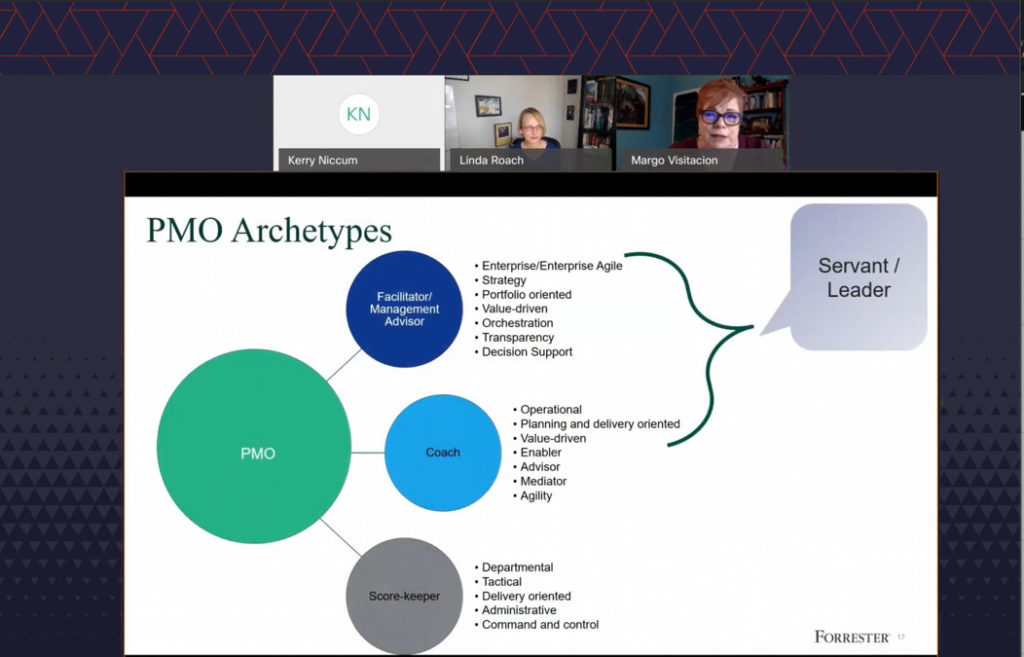
Q&A from an on-demand webinar featuring Forrester Guest Speaker, Margo Visitacion and Planview’s Solution Marketing Director, Linda Roach
The role of the PMO is changing. We recently got an in-depth look into this new face of the PMO during our webinar – “What’s Ahead for the PMO?” Our featured speaker was Margo Visitacion, Vice President and Principal Analyst for Forrester. She and I discussed the responsibilities, expanding skill sets, and strategic capabilities of the modern PMO – and how to advance in that direction.
We invite you to view the webinar for all of our discussion. In this blog we answer a few questions we didn’t have time to address during the live webinar.
Here’s a quick recap of key points about the evolving role of the PMO.

Types of Today’s PMOs
The PMO has been typically chartered as a central place for ensuring effective project delivery via adherence to a set of standards, procedures, and practices. As a trend, PMOs are maturing to become more strategic, facilitating the organizational agility needed to achieve objectives at speed.
During the webinar, Margo provided three “PMO Archetypes” that more accurately reflect the current state of PMOs:
- Scorekeeper: This “office of no” embodies the traditional, administrative role of the PMO. This archetype is more concerned with command and control of governance and methodologies than achieving relevant business outcomes.
- Coach: This more mature PMO is still operational but focused on supporting the organization as an enabler, advisor, and mediator. This archetype wants to foster the agility needed to achieve strategic outcomes.
- Facilitator/management advisor: This most advanced PMO archetype focuses on portfolios, not projects. These professionals are value-driven and committed to enterprise-wide Agile. They act as servant leaders, supporting teams, providing executive-level counsel, and removing roadblocks to agility and performance.

Measuring PMO Value and Benefits to the Organization
The conventional role of the PMO is to establish a set of best practices and processes to ensure that projects are executed in a structured, repeatable manner. This focus on improving operational efficiency has traditionally used “on time and on budget” as the success metrics.
Modern PMOs go beyond this to help the organization achieve business goals. These professionals advise leaders about which projects to undertake based on strategic objectives, resource capacity, risk, and other factors. They support teams in executing towards those objectives and measure success based on metrics such as growth, profitability, and customer loyalty.
Applying Objectives and Key Results (OKRs)
All types of organizations are using an objectives and key results (OKRs) framework for collaborative goal setting. Two descriptions from John Doerr’s “WhatMatters.com” web site show its relevance to the modern role of the PMO:
- “OKRs connect key results to objectives for a more strategic appropriation of resources and time with key results at the forefront.”
- OKRs are about “figuring out what really matters and getting that done in a time-bound, efficient manner so that it all improves performance” (in the context of Lean).
These benefits are motivating PMOs to start working with OKRs. The OKR structure creates realistic traceability with its ability to link strategy with outcomes. For more information about OKRs, see Doerr’s book “Measure What Matters.”
Here are the answers to several questions attendees asked during the webinar about the role of the PMO:
- Where should the PMO sit in an organization?
It’s not unusual for modern PMOs – those focused on strategic outcomes – to be at the C-level. This could be the strategic planning office or the chief strategy officer. If you have a chief digital officer working collaboratively with a CMO/CIO, then the PMO tends to be on that level. The important point here is that the PMO must be in a position where it can move the needle and not be siloed.
- What does the PMO drive from a business perspective versus IT?
In a perfect world, business and IT strategy are intertwined. In reality, a disconnect exists in many organizations. With digital transformation and technology so core to product development and the customer experience these days, the IT component becomes infused into the business strategy.
A big gap is created when the ‘business’ decides what they want to do and then throws it over to IT. The role of the PMO can be a facilitator that helps to identify what can be achieved based upon capacity milestone requirements. It becomes a bit of a negotiation: To achieve this ‘X’ business outcome, this ‘Y’ IT investment must be in place. This is one reason dependency management is so important. It starts at the investment level. How do you bring these strategies together?

- How do we measure value/benefits across the portfolio, where this is addressing risks in the IT landscape versus those that increase revenue or reduce costs?
Objective and key results (OKRs) can be used to define a set of meaningful metrics that measure value across the portfolio of investments. OKRs help the organization focus on the outcomes, whether from the corporate level or from the team. A corporate objective could be “grow the business while maintaining profitability,” using revenues as a key result. An aligned development team objective could be “Drive quality of new features,” using reduction of customer support cases as a key result.
Prioritization and funding decisions can then be based on the estimated impact that projects or programs have to these objectives. Program managers can then establish the process of reviewing the progress of key results. This review includes assessing whether projects or programs are still relevant based on the key metrics being tracked.
- How should the PMO align with agile practices?
February 11th of this year marked the 20th anniversary of the Agile Manifesto. Success in the early days had Agile teams questioning the relevance of the PMO. But that success often happened with a single product backlog and team. Teams and organizations didn’t think about scale creating complexity: When you get to team of teams, with 50 to 100 teams, it becomes a very complicated landscape very quickly. Flexible structure and portfolio management is still necessary, beneficial, and vital to organizational transformation.
Embracing Agile is vital for PMO evolution and success. The role of the PMO in an Agile organization is to support the autonomy and fail-fast mentality of Agile teams. This means applying just enough governance to ensure that the work aligns with strategy.
In organizations with multiple Agile teams, PMOs also help to mitigate the dependencies between teams. Executives with more widespread Agile and Lean practices in their organizations are more confident in organizational alignment, team focus, and on-time delivery of strategic objectives. This finding is from a recently published Global Benchmark Study – “The State of Strategy Execution” – commissioned by Planview. PMOs that transform their focus play a pivotal role in scaling Agile enterprise wide.
Today, executives are recognizing that current governance and approval processes slow down responsiveness to change. PMOs can lead the way to institute a set of flexible governance practices at the enterprise level.
- Do you believe the PMI definition of types of PMOs (supportive, controlling, directive) is out of date and irrelevant?
The PMI definition of three types of PMOs does not take the strategic aspects of the PMO into account. PMI’s definition of PMO is evolving to recognize its strategic role: “Strategic PMOs enable strategic change in organizations. PMOs vary widely. Some serve as a means to standardize project-related governance processes and facilitate sharing of resources and tools. Others serve as centers of excellence, and still others align project and program work to corporate strategy across an enterprise.”
Executives are expecting more strategic counsel and results from their PMOs, according to PMI’s Pulse of the Profession 2020 report. Their top three factors for future success involving PMOs were organizational agility (35%), choosing the right technologies to invest in (32%) and securing relevant skills (31%).
View the webinar for even more discussion, including recommendations on how PMOs can become strategic partners, agents for change, and coaches for their business.




